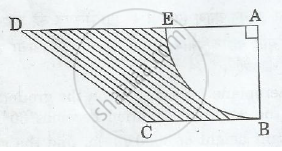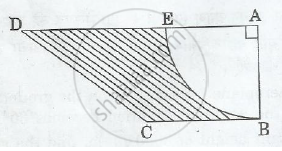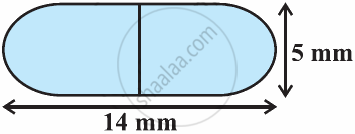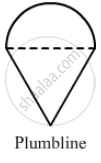Advertisements
Advertisements
प्रश्न
In Figure 2, ABCD is a trapezium of area 24.5 sq. cm. In it, AD|| BC, ∠ DAB = 900, AD = 10 cm and BC = 4 cm. If ABE is a quadrant of a circle, find the area of the shaded region. [Take π=22/7]

उत्तर

Given :-
AD = 10 cm
BC = 4 cm
Area of trapezium = 24.5 cm2
Area of trapezium = `(a+b)/2 height [`
`=(AD+BC)/2 AB`
`24.5=(10+4)/2 AB`
`24.5/7=AB`
AB = 3.5 cm
Thus, radius = 3.5 cm
Area of quadrant = Area of a circle / 4
Area of quadrant `= 1/4 xx pi xx r2 = 0.25 xx 22/7 xx3.5 xx 3.5 = 9.625 cm^2`
The area of shaded region = Area of trapezium – Area of the given quadrant
The area of shaded region = 24.5 - 9.625 = 14.875 cm2
APPEARS IN
संबंधित प्रश्न
150 spherical marbles, each of diameter 1.4 cm, are dropped in a cylindrical vessel of diameter 7 cm containing some water, which are completely immersed in water. Find the rise in the level of water in the vessel.
A medicine capsule is in the shape of cylinder with two hemispheres stuck to each of its ends (see the given figure). The length of the entire capsule is 14 mm and the diameter of the capsule is 5 mm. Find its surface area. [Use π = `22/7`]

From a solid cylinder whose height is 2.4 cm and diameter 1.4 cm, a conical cavity of the same height and same diameter is hollowed out. Find the total surface area of the remaining solid to the nearest cm2
[use `pi = 22/7`]
Radii of circular ends of a solid frustum off a cone re 33cm and 27cm and its slant height are 10cm. find its total surface area?
Two cubes each of volume 27 cm3 are joined end to end to form a solid. Find the surface area of the resulting cuboid.
A rocket is in the form of a circular cylinder closed at the lower end and a cone of the same radius is attached to the top. The radius of the cylinder is 2.5 m, its height is 21 m and the slant height of the cone is 8 m. Calculate the total surface area of the rocket.
How many cubes of 10 cm edge can be put in a cubical box of 1 m edge?
A plumbline (sahul) is a combination of

If the areas of three adjacent faces of a cuboid are x, y and z, respectively, the volume of the cuboid is ______.
If two solid hemispheres of the same base radius r are joined together along their bases, then curved surface area of this new solid is ______.
